In keeping with my self-imposed Holiday tradition here’s another pick of British Annuals selected not just for nostalgia’s sake but because it’s my house and my rules…
After decades when only American comics and memorabilia were considered collectable or worthy, the resurgence of interest in home-grown material means there’s lots more of this stuff available and if you’re lucky enough to stumble across a vintage volume or modern facsimile, I hope my words convince you to expand your comfort zone and try something old yet new…
Still topping my Xmas wish-list is further collections from fans and publishers who have begun to rescue this magical material from print limbo in (affordable) new collections…
Great writing and art is rotting in boxes and attics or the archives of publishing houses, when it needs to be back in the hands of readers once again. As the tastes of the reading public have never been broader and since a selective sampling of our popular heritage will always appeal to some part of the mass consumer base, let’s all continue rewarding publishers for their efforts and prove that there’s money to be made from these glorious examples of our communal childhood.
The Dandy Monster Comic (Dandy Annual 1939 Special Facsimile Edition)
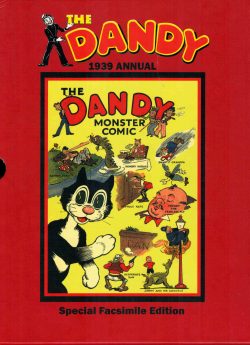
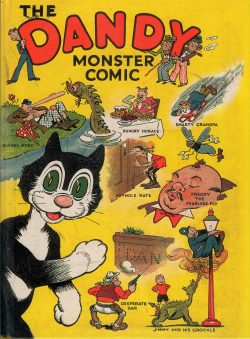
By Many and various (DC Thomson & Co/Aurum Press)
ISBN: 978-1- 84513-217-0
This one’s actually older than me – at least in its original incarnation…
Until it folded and was reborn as a digital publication on 4th December 2012, The Dandy was the third longest running comic in the world (behind Italy’s Il Giornalino – launched in 1924 – and America’s Detective Comics in March 1937).
Premiering on December 4th 1937, The Dandy broke the mould of traditional British predecessors by using word balloons and captions rather than narrative blocks of text under the sequential picture frames.
A colossal success, it was followed eight months later (on July 30th 1938) by The Beano and together they completely revolutionised the way children’s publications looked and, most importantly, how they were read.
Over the decades the “terrible twins†spawned a bevy of unforgettable and beloved household names who delighted generations of avid and devoted readers, and the end of year celebrations were graced with bumper bonanzas of the comics’ weekly stars in extended stories in magnificent bumper hardback annuals.
As WWII progressed, rationing of paper and ink forced the “children’s papers†into an alternating fortnightly schedule: on September 6th 1941 only The Dandy was published. A week later just The Beano appeared. They only returned to normal weekly editions on 30th July 1949…
As of this grand festive feast however that’s all in the future. Here, masterfully restored, is a treasure trove of joyous pranks and all-ages adventure to delight and enthral. It should be noted however, that all this buffoonery and jolly japery was crafted at a time socially far-removed from our own, and there are some terms and racial depictions that wouldn’t be given houseroom in today’s world. That was then, this is now, and that’s another thing you can be grateful for…
It all opens in classis DCT manner with the entire cast chowing down to a monumental feast – a staple reward of those leaner, impoverished times – before James Crichton’s ‘Korky the Cat’ kicks things off with spot of calamitous dockside fishing after which ‘Jimmy and his Grockle’ – a kind of Doberman dragon – foils a dognapping ring. Illustrated by James Clark, the strip was recycled from prose “Boys Paper†The Rover (where it was “Jimmy Johnson’s Grockle†in 1932).
Most pages come with riddles, jokes or single panel gags and many of the strips are delivered in the signature two colour process that typifies British Annuals and as usual none of the writers are named and precious few of the artists are credited. As always, I’ve offered a best guess as to whom we should thank, and of course I would be so very happy if anybody could confirm or deny my suppositions…
The prolific Allan Morley then details how ‘Keyhole Kate’ falls foul of a burglar and cowboy superman ‘Desperate Dan’ – by indisputable key man Dudley D. Watkins – braves harsh winter clime, before Morley’s ‘Freddy the Fearless Fly’ thwarts a human bully and thrashes a predatory spider.
These colossal tomes were all about variety and value for money and next up is a heavily-illustrated prose story enthrallingly detailing the feudal adventure of young shepherd-boy Gingan‘s dragon-slaying quest with magical weapon ‘The Sword of Crad’ after which wandering tramp ‘Barney Boko’ comes a-cropper after defacing public property in a wordless strip from John R. Mason.
As depicted by the superb Eric Roberts, ‘Podge’s Frame-Up’ sees the junior entrepreneur confusing art galleries with glaziers whilst nattily-dressed ‘Archie the Ape’ deals with a hungry lion and ‘Smarty Grandpa’ (by Watkins and a double for strip veteran Pa Broon) has a racially-charged moment at a minstrel show before anthropomorphic tortoise ‘Dan the Night-watchman’ confronts a gang of thieving rats…
‘The Boy that Beat the Band’ is another prose drama (illustrated by Fred Sturrock?) with a young orphan acrobat saving a disabled boy and rewarded with his heart’s desire – a job – after which Jack Glass’ text-block and pic strip ‘The Daring Deeds of Buck Wilson’ sees the singing cowboy battle kidnappers before the animal antics in ‘Bamboo Town’ see daring duo Bongo and Pongo organise a therapeutic gymnasium in a typically busy romp limned by Charlie Gordon.
Sam Fair’s ‘Wig and Wam the Skookum Kids’ were prank-playing Red Indian lads who here trick the Big Chief into baiting a bear before ‘Flippy the Sea Serpent’ – by Frank Minnitt – settles the hash of a snooty octopus whilst Smarty Grandpa fails to steal a pie…
Boneless Bill was a long-running but sadly anonymous strip starring an affable contortionist. Here he astounds an army recruiting officer before ‘Marmaduke Mean the Miser’ pays painfully for stealing a little lad’s Dandy comic before ‘Hungry Horace’ (Morley) finds his appetite briefly diminished after illicitly tapping the wrong barrel and a cunning old codger prevents a mugging in ‘Old Beaver’s Brainwaves’.
‘Wee Tusky’ was long-running prose feature and here the baby elephant’s propensity for trouble leads to deadly danger but secures him a human friend in the end, after which Roberts’ ‘Helpful Henry’ adjusts seating arrangements despite his history of calamitous consequences just as pompous (idiot) detective ‘Trackem Down’ botches another “caseâ€â€¦
Korky the Cat masters the fundamentals of golf whilst Jimmy and his Grockle find fun – and bananas – at the docks, after which Keyhole Kate’s snooping drenches a helpful bystander and Desperate Dan proves that building sites can be dangerous places… at least for other people…
After another get-rich-quick scheme from Podge, sausage-snaffling ‘Dipper the Dodger’ falls foul of the law. Probably drawn by James Jewell, Dipper is a dead ringer for Beano and The People’s Journal cartoon stalwart Wee Peem (“He’s a Proper Screamâ€), so there might have been some cross-pollination back then.
Freddy the Fearless Fly turns arsonist to escape a spider’s trap before Helpful Henry learns the perils of electricity, after which Jimmy Denton tries rodeo riding to save the ranch with the invaluable assistance of ‘White Star’s Star Turn’ in a prose thriller that leads seamlessly to Podge setting up his own postal service before ‘Bobby, the Boy Scout’ goes too far in his scheme to help a hobo…
Boneless Bill artfully apprehends a thief and Archie the Ape find busking hazardous to health, whilst Hungry Horace loses his lunch to a quick-witted sprinter, but savvy navies ‘Nick & Nack’ find a smart way to keep the cops from confiscating their grub.
Interfering busybodies Bobby, the Boy Scout and Helpful Henry both get it wrong again, after which we head west to see Wig and Wam the Skookum Kids prank their dad yet again even as Desperate Dan falls asleep in the park but still causes chaos
‘Willing Willie and his Pa’ experience decorating woes before we revisit the days of the Raj in prose thriller ‘Pam the Peace-Maker’ wherein a little girl prevents an outbreak of war after which Helpful Henry confuses radio and electric irons and Korky triumphs over a tiger when he goes on safari.
Jimmy and his Grockle clash violently with shopkeepers and Old Beaver’s Brainwaves sees the gamey geezer getting back at the thug who pinched his job after which itinerant Barney Boko pays through the nose for watching football without a ticket.
Dipper the Dodger meets a theatrical strongman and the Bamboo-Town boys convene a swimming class that would certainly have benefitted ‘Sandy Starfish, the Shipwrecked Sailor’ before Fred Sturrock illustrates a prose battle of wits between stubborn old men in ‘The House that Jack the Joker Built’.
More musical mayhem from Archie the Ape precedes Hungry Horace outwitting municipal bylaws in search of a big scoff, even as Podge dupes another crowd of sensation hungry oafs and Helpful Henry wrecks a house before it’s even built: a trick even Desperate Dan can’t match, even if he wasn’t so thirsty…
Mini vignettes for Podge, Barney Boko and Boneless Bill lead into a riotous schoolboy romp in prose – probably illustrated by George Ramsbottom – that I want you to be grown up about. ‘Invisible Dick Spoofs the Spoofer’ is a smart tale from a venerable feature that ran in The Rover for years and when he turns the tables on a cruel stage magician humiliating his school chums you should be proud and not titter or snigger…
A rapid-fire tranche of cartoon antics, starring Bobby the Boy Scout, Podge, Marmaduke Mean the Miser, Flippy the Sea Serpent, Boneless Bill and Willing Willie and his Pa, lead us to another text tale as animal-raised orphan ‘Buffalo Boy’ discovers toffee and begins his slow march back to civilisation…
From here it’s cartoon strip all the way with Korky, Keyhole Kate, Freddy the Fearless Fly, Helpful Henry, Wig and Wam the Skookum Kids, Smarty Grandpa and Dipper the Dodger all doing what they do best before Bamboo-Town brings down the curtain as Bongo and Pongo build an all-animal skating rink…
A marvel of nostalgia and timeless comics wonder, the true magic of this facsimile edition is the brilliant art and stories by a host of talents that have literally made Britons who they are today, and bravo to DC Thomson for letting them out for a half-day to run amok once again.
The DANDY is a trademark of and © D. C. Thomson & Co. Ltd. 2006. Associated characters, text and artwork © D. C. Thomson & Co. Ltd. 2006. All rights reserved.
Valiant Annual 1968
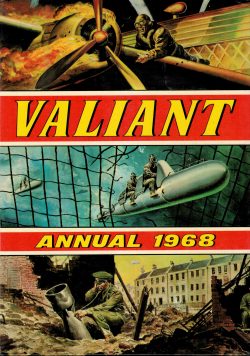
By Many & various (Fleetway)
No ISBN
From the late 1950s and increasingly through the 1960s, Scotland’s DC Thomson steadily overtook their London-based competitors – monolithic comics publishing giant Amalgamated Press.
Created by Alfred Harmsworth at the beginning of the twentieth century, AP perpetually sought to regain lost ground, and the sheer variety of material the southerners unleashed as commercial countermeasures offered incredible vistas in adventure and – thanks to the defection of Leo Baxendale and Ken Reid to the enemy – eventually found a wealth of anarchic comedy material to challenge the likes of the Bash Street Kids, Dennis the Menace, Minnie the Minx and their unruly ilk.
During the latter end of that period the Batman TV show sent the entire world superhero-crazy. Amalgamated had almost finished absorbing all its other rivals such as The Eagle‘s Hulton Press to form Fleetway/Odhams/IPC and were about to incorporate American superheroes into their heady brew of weekly thrills.
Once the biggest player in children’s comics, Amalgamated had stayed at the forefront of sales by latching onto every fad: keeping their material contemporary, if not strictly fresh. The all-consuming company began reprinting the early successes of Marvel comics for a few years; feeding on the growing fashion for US style adventure which had largely supplanted the rather tired True-Blue Brit style of Dan Dare or DC Thompson’s Wolf of Kabul.
Even though sales of all British comics were drastically declining, the 1960s were a period of intense and impressive innovation with publishers embracing new sensibilities; constantly trying new types of character and tales. At this time Valiant and its stable-mate Lion were the Boys’ Adventure big guns (although nothing could touch DC Thomson’s Beano and Dandy in the comedy arena).
Valiant was conceived as a “Boys’ Paper†in 1962 as the indigenous comics industry struggled to cope with a sudden importation of brash, flashy, full-colour comics from America. A weekly anthology concentrating on adventure features and offering a constantly changing arena of action, the magazine was the company’s most successful title for over a decade: absorbing many less successful periodicals between its launch and eventual amalgamation into new-styled, hugely popular Battle Picture Weekly in 1976.
There were 21 Annuals between 1964 to 1985, combining original strips with prose stories; sports, science and general interest features; short humour strips and – increasingly from the 1970s onwards – reformatted reprints from IPC/Fleetway’s vast back catalogue.
From their creative heyday (this book would have been on sale from the autumn of 1967) and sporting a gripping Don Lawrence cover, the all-boys excitement begins with a frontispiece spread of medal-winning British hero war heroes: a typical illustrated historical feature of the era.
The drama continues with a fictionalised full-colour tale of smugglers and the development of the customs men in ‘Contraband’ before ‘Kelly’s Eye’ – sublimely painted by Carlos Cruz (I think) – sees the indestructible adventurer saving beleaguered Coroba from revolutionaries and radioactive doom.
Kelly’s Eye featured ordinary, thoroughly decent chap Tim Kelly who came into possession of the mystical “Eye of Zoltecâ€: a fist-sized gem that kept him free from all harm… as long as held on to it.
You won’t be surprised to discover that, due to the demands of weekly boys’ adventures, Tim lost, dropped, misplaced and was nefariously deprived of that infernal talisman pretty darned often – and always at the most inopportune moment…
The moody and compelling artwork of Argentinean Francisco Solano Lopez was the prime asset of this series, with Tom Tully and Scott Goodall the usual scripters for this little gem of a series.
Resorting to economical monochrome, we come to ‘The House of Dolmann’. The weekly strip was a curious and inexplicably absorbing blend of super-spy and crime-buster strip from Tully and utterly wonderful master illustrator Eric Bradbury. Dolman’s cover was as a shabby ventriloquist (I digress, but an awful lot of “our†heroes were tatty and unkempt – we had “Grunge†down pat decades before the Americans made a profit out of it!) who designed and constructed an army of specialised robots which he disguised as his puppets.
Using these as his shock-troops, the enigmatic Dolman waged a dark and crazy war against the forces of evil…
Here, he and his hand-crafted squad hunted a scientific maniac pulling satellites out of the sky with a super-magnet.
The first photo/fact feature of the book is a thinly-disguised infomercial for a popular outdoor activity charity, propounding readers get ‘Outward Bound – to Adventure’ after which ‘The Steel Claw’ battles a madman and his gang determined to destroy Britain’s navy (illustrated, it seems to me, by Massimo Belardinelli).
One of the most fondly-remembered British strips of all time, the Steel Claw, ran from 1962- 1973 with Jesús Blasco and his small family studio enthralling the nation’s children through the breakneck adventures of scientist, adventurer, spy and even costumed superhero Louis Crandell. Initially written by novelist Ken Bulmer, the majority of the character’s career was scripted by Tully. Crandall had an artificial hand packed with gimmicks and possessed the disquieting ability to turn invisible whenever he was electrocuted…
‘The Astounding Jason Hyde’ was a series that ran in prose form, written by Barrington J. Bayley with spot illos from Bradbury. Hyde was a blind telepath with an “X-Ray mind†who here tracks missing potholers to an unsuspected cave civilisation populated by brutes and monsters…
After all that action and suspense it’s past time for some light relief and a brace of comedy capers follows: frenetic trend-chasers and backyard inventors ‘The Nutts’ cause carnage with their climate-challenging antics in a superb extended yarn from Spanish cartoonist Ãngel Nadal whilst the astoundingly slick and wonderful ‘Sporty’ by Reg (Sporting Sam) Wootton learns a lesson about truth in advertising…
Appalling racist by today’s standards, ‘Captain Hurricane’ was a hugely popular strip for its entire decades-long run. Written by Scott Goodall or Jon Rose, he was originally drawn by R. Charles Roylance, but I think it’s either Jack Pamby or Fred T. Holmes limning this bizarre yarn as – thanks to skiving batman Maggot Malone – the marines are forced to fight their way through Japanese-controlled Malayan jungles to Singapore, armed with nothing but cricket equipment……
Brilliant Reg Parlett’s ‘The Crows’ see the youngest corvid cavorting with bats before – in scintillating pink duo-tones – ‘The Wild Wonders’ (Mike Western and probably Tully on script) offer comedic drama capers. Here Rick and Charlie Wilde and their long-suffering guardian Mike Flynn face ski-slope thrills with a side-order of kidnap and skulduggery… Shipwrecked on remote Worrag Island in the Hebrides, two toddlers were raised by animals and survived to become almost superhuman specimens. When rescued by Olympic swimmer Mike they became sporting sensations able to out-compete most adult athletes in any discipline. They could also talk to animals…
‘Tatty-Mane, King of the Jungle’ offers raucous animal antics as the regal rogue seeks to update his look, but the artist remains a mystery to me. Likely candidates include Nadal or Martz Schmidt (suggested by Steve Holland – you really should read his Bear Alley blog)…
A ‘Sporting Roundabout’ of facts lead into a prose tale of exploration and treasure hunting – illustrated by Weston – with the good guys using an ambulatory super-jeep dubbed ‘The Jungle Walker’ after which venerable schoolboy comedy property ‘Billy Bunter’ quits school and heads out to sea, encountering spies in a quirky yarn possibly illustrated by Parlett but it seems reminiscent of Frank Minnitt to me…
‘Legge’s Eleven’ was a typical example of the humorous freak-show football strip. Lanky player-manager Ted Legge took over failing Rockley Rangers and fields a team of misfits and individualists he struggles to make work together. Here the lads are trapped in a spiral of superstition and missing mascots in the run-up to a crucial international second leg…
Following ‘The Crows’ fowling up a wildlife film, ‘Operation “Rescue‒ (by Mike White?) recreates the 1957 efforts to save Royal Army Air Servicemen lost in the jungles outside Kuala Lumpur before a double dose of ‘“Horse†Laughs’ gags segues into a photo-packed footballing essay on ‘Great Moments with Great Clubs’.
Back in comics, ‘Captain Hurricane’ and crew are in the Western Desert in 1940, battling Italian infantry even as Maggot Malone spreads disorder with his latest fad: weightlifting…
‘Sporty’ disastrously discovers Squash and ‘The Nutts’ cause carnage on a film set before ‘Billy Bunter’s enforced diet creates carnage for the entire county after which another ‘Sporting Roundabout’ leads to a prose thriller about a multi-talented circus performer battling crooks attempting to fix his championship boxing match in ‘The Flying Fighter’.
‘Gabby McGlew – his yarns aren’t true’ is an example of recycled Buster strip Barney Bluffer by Nadal with boastful braggart channelling his inner Baran Munchausen after which photo-history feature ‘A Champion Champion’ details the career and achievements of Henry Cooper before everything wraps up with what I’m sure is another re-tread, even if I can’t find out where.
‘No. 13 Grimm Street’ sees Fleet Street reporter “Hack†Mackenzie struggling to solve a spree of daring art robberies and a house that seems to vanish at will: the answer to both mysteries leads to madness and death…
Eclectic, wide-ranging and always of majestically high quality, this blend of fact, fiction, fun and thrills is a splendid evocation of lost days of joy and wonder. We may not be making books like this anymore but at least they’re still relatively easy to track down. Of course, what’s really needed is for some sagacious publisher to start re-issuing them…
© Fleetway Publications Ltd., 1967
Star Trek Annual 1976
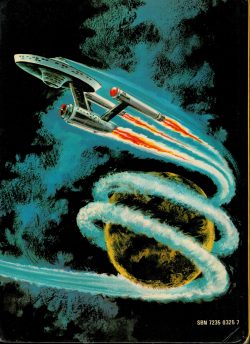
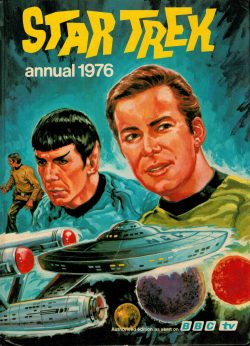
By John David Warner, Allan Moniz, Alberto Giolitti & various (World Distributors)
SBN: 7235-0325-7
British Comics have always fed heavily on other media and as television grew during the 1960s – especially the area of children’s shows and cartoons – those programmes increasingly became a staple source for the Seasonal Annual market. There would be a profusion of stories and strips targeting not readers but young viewers and more and more often the stars would be American not British.
Much of this stuff wouldn’t even be as popular in the USA as here, so whatever comic licenses existed usually didn’t provide enough material to fill a hardback volume ranging anywhere from 64 to 160 pages. Thus, many Annuals such as Daktari, Champion the Wonder Horse, Lone Ranger and a host of others required original material or, as a last resort, similarly-themed or related strips.
This book was produced in a non-standard UK format, with limited but full-colour for both the American comics reprints and the remainder: brief prose pieces, puzzles, games and fact-features on related themes. As for the writers and artists of the originated material your guess is, sadly, as good as or better than mine, but almost certainly generated by the wonderful Mick Anglo’s publishing/packaging company Gower Studios (these yearly slices of screen-to-page magic were an intrinsic part of growing up in Britain for generations and still occur every year with only the stars/celebrity/shows changing, not the package.
Star Trek launched in the USA on September 8th 1966, running until June 3rd 1969: three seasons comprising 79 episodes. A moderate success, the show only really achieved its stellar popularity after going into syndication; appearing in all American local TV regions perpetually throughout the 1970s and beyond.
It was also sold all over the world, popping up seemingly everywhere and developing a fanatically devoted fanbase.
Comicbook franchising specialist Gold Key produced a series which ran for almost a decade beyond the show’s cancellation. Initially these were controversially quite dissimilar from the screen iteration, but by the time of the tales in this sturdy Holidays hardback (reprinting Gold Key’s Star Trek issues #27and #30 from November 1974 and May 1975), quibbling fans had little to moan about and a great deal to cheer as the series was the only source of new adventures starring the beloved crew of the Starship Enterprise.
John David Warner scripted ‘Ice Journey’ and it was illustrated by the ever-amazing Alberto Giolitti. Here the Enterprise is conducting a highly-suspect population survey on sub-arctic world Floe I which soon drops Captain Kirk, Mr. Spock and evolutionary specialist Dr. Krisp into the middle of a eugenics-fuelled race war…
Dividing the tale are a brace of UK generated features a compendium of ‘Star Facts’ offering seven salient snippets of astronomical amazement and a ‘Cosmic Crossword’ to challenge your knowledge of the infinite unknown.
Following the conclusion of ‘Ice Journey’, there’s a board game to play at ‘Warp Factor Eight’ before a second serving of ‘Star Facts’ ushers in another comics adventure.
Bisected by an illustrated glossary of ‘Space Age Vocabulary’, Death of a Star’ (by Allan Moniz & Giolitti) comes from Star Trek #30 and finds Enterprise on site to observe a star going nova. The ship is subsequently catapulted into calamity as sensors pick up a planet full of life-readings where none should be. Moving swiftly to evacuate the endangered beings, the crew are astonished to discover only one creature: an old woman who claims to be the dying sun…
Thanks to the vagaries of image licensing, one thing you won’t find herein is a single photograph of any cast member, but there are plenty of nostalgia-tinged, all-ages sci fi thrills and dashing derring-do to delight not just TV devotees and comics fans but also any reader in search of a pictorially powerful grand adventure.
© MCMLX, MCMLXI, MCMLXXII, MCMLXXV Paramount Pictures Corporation.
(These days Star Trek and related marks are trademarks of CBS Studios, Inc.) All Rights Reserve
